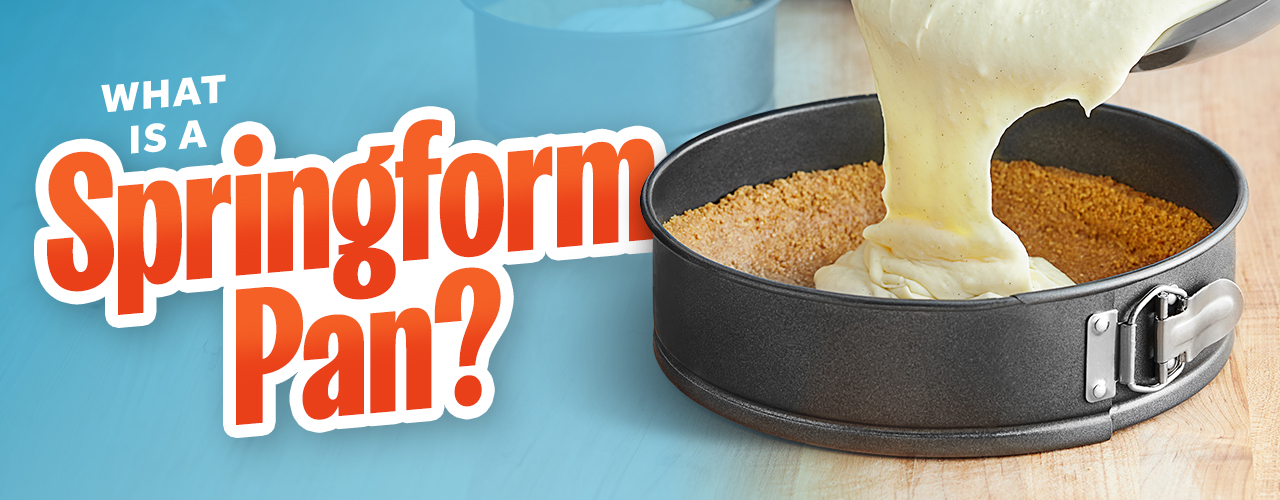A springform pan is a round cake pan that features a removable bottom and sides. The sides are held together with an interlocking band that can be opened and removed once your baked good is out of the oven, leaving your cake on the base. This unique design allows for the easy release of delicate baked goods, such as cheesecakes and tortes, without damaging their structure. Springform pans are typically made of durable materials such as aluminum or stainless steel, ensuring their longevity in a busy commercial kitchen. Their ability to create perfectly shaped and evenly baked desserts makes them a must-have tool for professional bakers and pastry chefs.
Shop All Springform PansHow to Use a Springform Pan

Springform pans are easy to use and can help produce a flawless final product. Follow these easy steps to learn how to use a springform cake pan.
- Secure the sides: First, ensure your bottom and sides fit together securely. This can help reduce or eliminate leakage.
- Line the pan (optional): Depending on your recipe, you may want to line the bottom and sides of your pan with parchment paper, especially if the pan is not nonstick.
- Fill pan: Once the sides and bottom are put together and the clamps are shut, fill the pan with your desired ingredients.
- Bake and cool: Bake to completion according to the recipe and let cool.
- Loosen the edges: If you are not using a nonstick pan, use a butter knife to loosen the edges around the sides. For nonstick pans, use a small rubber spatula or scraper.
- Remove sides: Unhinge the clasp and remove the sides.
- Serve: Remove the bottom by carefully lifting it with a spatula and sliding the cake onto a tray, or serve directly on the springform pan base.
How to Use a Springform Pan for Cheesecake

When it comes to making the perfect cheesecake, using a springform pan is essential for achieving a beautiful presentation and easy removal. Here are the steps to properly use a springform pan for making a cheesecake:
- Prepare the crust: Start by preparing your crust mixture and press it evenly into the bottom of the springform pan.
- Pre-bake the crust (optional): Some recipes may call for pre-baking the crust before adding the filling to create a crisp and sturdy crust. Graham cracker and cookie crusts do not usually call for pie weights to blind bake them. Follow the instructions of your recipe accordingly.
- Prepare the filling: Mix your cheesecake filling ingredients together until smooth and creamy.
- Secure the sides of the pan: Make sure to securely fasten the sides by aligning the interlocking edges.
- Pour the filling into the pan: Once your filling is ready, pour it into the springform pan over the crust. Use a spatula to smooth and even out the top.
- Bake the cheesecake: Place the springform pan on a baking sheet to catch any potential drips and transfer it to the preheated oven. Baking times can vary depending on the size and thickness of your cheesecake.
- Cool and refrigerate: Remove the cheesecake from the oven and let it cool in the pan on a wire rack as it sets and firms up. Once cooled, refrigerate the cheesecake for several hours or overnight to ensure it is fully set before serving.
- Release the sides of the pan: After refrigerating, remove the sides of the springform pan. Carefully unlatch the sides and lift them away from the cheesecake. The bottom of the pan can be left in place for easy serving, or transfer the cheesecake to a serving plate.
Springform Pan Sizes
Springform pans come in various sizes to accommodate different recipes and baking needs. Most springform pans range in diameter from 6 to 10 inches and have a depth of 2 to 3 inches. Here are some common springform pan sizes and their uses:

- 6-inch Springform Pan: Suitable for making small individual-sized tarts.
- 8-inch Springform Pan: A popular size for baking tortes and cakes.
- 9-inch Springform Pan: The most commonly used size for baking cheesecakes and quiches.
- 10-inch Springform Pan: Ideal for larger gatherings or when you want to make a larger cheesecake or a deep-dish pie.
Springform Pan Alternative
If you find yourself in need of a springform pan substitute, the following methods have the potential to mimic its effects:
- Line a traditional pan with parchment paper or aluminum foil. Leave plenty of material hanging outside of the pan. With the help of another pair of hands, hold the pan down and lift the edges of the paper out from the pan. This will create a sling for your baked good and hopefully keep it intact as it’s removed from the pan.
- Use a disposable cake pan. Disposable cake pans are typically made of aluminum or other lightweight materials and are designed to be discarded after use. Once your product is cooked and cooled, you can use a knife and scissors to cut the pan away from your dessert.
- Use paper baking molds. Paper baking molds are made of oven-safe paper and come in various shapes and sizes, including round, square, and rectangular. They are designed to be used for baking and can be easily removed once they are done. To use a paper baking mold, simply place it on a baking sheet, fill it with the batter, and bake according to the recipe's instructions. Once the baked goods have cooled, you can simply peel away the paper mold.
Springform Pan Uses

Springform pans are designed primarily for use with delicate dishes that cannot be easily removed or flipped from the pan. Below are some baked goods and savory meals to create with your springform pan:
- Cheesecake
- Ice cream cake
- Flourless cake
- Bread pudding
- Chocolate Pear Cake
- Fruit tart
- Frozen mocha torte
- Rigatoni pie
- Lasagna
- Garlic cheese bread
- Chicken pot pie
Why Is My Springform Pan Leaking?
Springform pans are a popular choice for baking delicate desserts such as cheesecakes and tortes. However, due to their convenient break-apart design, springform pans are prone to leaking. These are a few reasons why springform pan leaks might happen and how to prevent them.
- The pan may not have been properly sealed. Make sure to double-check that the bottom and sides are securely fastened together.
- The pan may become worn or damaged. Choosing a high-quality, leakproof pan for your commercial kitchen is recommended to avoid immediate leaking issues or to help reduce the chance of a problem developing in the future.
- The batter is too thin. Springform pans are not designed to hold runny batters or liquids, so be cautious when using them for recipes with high liquid content.
Springform pans feature an innovative design for effectively extracting your delicate cakes, pies, and tarts. Keeping your product intact from start to finish ensures an enticing and professional presentation, whether it's served right away or put on display in your bakery or restaurant.



